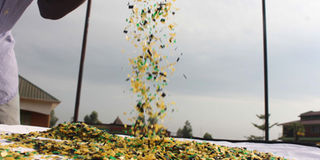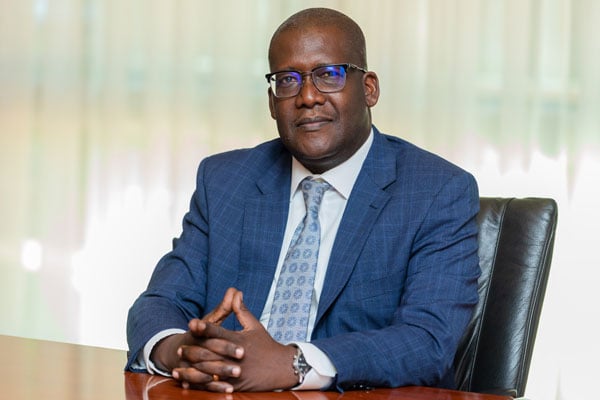Terrazzo from recycled plastics

Plastic chips used in making terrazo tiles.
What you need to know:
For decades, terrazzo has been used as a durable flooring material in construction. Now, 23-year old Anthony Kasumba recycles plastic waste into terrazzo, Dorothy Nakaweesi writes
Imagine a floor made out of recycled plastic waste: Terrazzo.
Terrazzo is a composite material poured in place or precast, which is used for floor and wall treatments.
It consists of chips of marble, quartz, granite, glass, or other suitable material, poured with a cementitious binder, polymeric or a combination of both.
This new creation could save the environment from littered plastics and polythene particles mixed with white cement.
Plastics are ‘non-biodegradable’ material. Not only are they harmful to our health but also the health environment. They are one of the major causes of environmental pollution.
Anthony Kasumba, a 23-year old- innovator from SINA (Social Innovation Academy) in Mpigi District is the brain behind terrazzo from fused polythene bags and plastics wastes.
SINA tackles failing education and resulting unemployment in Uganda through creating self-organised and responsible learning spaces, where disadvantaged youth unleash their potential for positive change as social entrepreneurs.
Kasumba, a Form Six dropout enrolled at SINA early this year.
In a Prosper Magazine interview, Kasumba exzplains what prompted him to start this business.
“I detest plastic Kaveera. So when I was challenged to come up with an innovation, my mind ran to plastic waste because they travel long distances by wind and water to pollute nature.”
Since polythene bags are lightweight; they get easily find their way into wind.
Plastic bags produce toxic fumes when is burnt. Due to leaching of toxic dyes from plastic bags, polyethene bags can easily contaminate food products. It also affects agriculture, land, environment due to pollution caused by plastic bags.
Environment enthusiasts say plastics should be banned as way of reducing plastic big waste. China banned plastic bags and four years later, the amount of plastic bags thrown into the environment had reduced by 40 billion.
In the region Kenya, Rwanda and Tanzania have implemented laws on polythene bags use although Uganda is still lagging behind in implementing this ban.
Idea
To develop his creation together, Kasumba with two cohorts visited Coca Cola recycling plant to further sharpen his idea of recycling plastics.
“When I visited Coca Cola recycling plant, I was amazed at how they cut the plastic caps and export them to China,” he said.
Recycling these plastic caps has created two benefits: while plastic waste is greatly reduced, all the caps are exported.
The process of cutting, sieving and packing the caps left piles of unwanted smaller particles which were then dumped.
“The piles of rescues or unwanted particles were still dangerous to the environment because they couldn’t decompose,” Kasumba explained.
This is how he hatched the idea of using these particles as a raw material in terrazzo production.
Process
Besides the plastic rescues, Kasumba also fuses plastic bags further cut into smaller particles which are used as raw material to make terrazzo.
When they collect the plastic waste particles, they soak them in water for a day or two to allow the plastics to separate from other residues such as paper. Then they remain with plastics alone. These plastics are mixed with white cement and then molded into block-like slabs.
Ideally, he mixes 70 per cent of the small plastic particles with white cement plus water and pours the mixture in molds.
Then when the mixtures form slabs, they are then rolled, ground and polished to make smooth tile-like structures – terrazzo plates – that can be used in constructing floors.
“We believe having a veranda or floor made out of this kind of terrazzo will save the environment,” he says with a beaming smile.
Opportunity
Kasumba working through his brand called ‘WasteOn Global’ has got an opportunity to construct floors at Coca Cola Recycling plant using his creation.
He is optimistic that this assignment will enable him to showcase his innovation to other clients.
Challenge
Just like any other young innovators, his challenge is to access a machine to cut the plastic into smaller particles to ease his work.
“I have sent samples to Germany through a friend to help me check whether I can get the cutting machine. But also local options like at Katwe will be of help,” he says.




